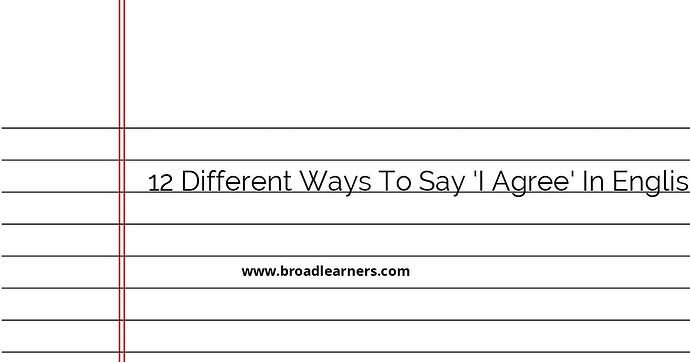When engaging in conversations, it's common to express agreement with others. Saying 'I agree' repeatedly can become monotonous. To add variety and depth to your conversations, here are 12 different ways to say 'I agree' in English:
- I concur
- That's right
- Exactly
- Definitely
- Absolutely
- For sure
- Indeed
- You're right
- No doubt
- Without a doubt
- Agreed
- True
Each of these phrases can be used interchangeably with 'I agree' to express your support or alignment with someone's statement or opinion. Let's explore some examples to understand how each phrase can be used:
1. I concur
'I concur' is a more formal way of expressing agreement. It is often used in professional or academic settings. For example:
Colleague A: 'I believe implementing this new strategy will improve our sales.'
Colleague B: 'I concur. It seems like a promising approach.'
2. That's right
'That's right' is a casual and colloquial way to agree with someone. It is commonly used in everyday conversations. For example:
Friend A: 'The movie was fantastic!'
Friend B: 'That's right! The acting was superb.'
3. Exactly
'Exactly' is a concise way to express agreement. It emphasizes that you completely agree with the statement. For example:
Teacher: 'The answer to question five is 42.'
Student: 'Exactly! That's what I wrote too.'
4. Definitely
'Definitely' is a strong affirmation of agreement. It shows certainty and conviction in your agreement. For example:
Colleague A: 'We should prioritize customer satisfaction.'
Colleague B: 'Definitely! Happy customers are key to our success.'
5. Absolutely
'Absolutely' expresses complete agreement and enthusiasm. It conveys a high level of agreement. For example:
Friend A: 'Do you want to go to the concert?'
Friend B: 'Absolutely! I've been waiting for this opportunity.'
6. For sure
'For sure' is a casual way to express agreement. It indicates certainty and agreement. For example:
Sibling A: 'We should order pizza for dinner.'
Sibling B: 'For sure! I'm in the mood for pizza.'
7. Indeed
'Indeed' is a more formal way to agree. It adds emphasis to your agreement and is often used in formal or professional discussions. For example:
Professor: 'The results of the study are consistent with our hypothesis.'
Student: 'Indeed, the data supports our initial predictions.'
8. You're right
'You're right' acknowledges and agrees with the other person's statement. It shows that you recognize their correctness. For example:
Colleague A: 'We need to allocate more resources to marketing.'
Colleague B: 'You're right. It will help us reach a wider audience.'
9. No doubt
'No doubt' expresses complete certainty and agreement. It indicates that there is no room for doubt in your agreement. For example:
Friend A: 'The food at that restaurant is amazing!'
Friend B: 'No doubt! I've never had a bad meal there.'
10. Without a doubt
'Without a doubt' is similar to 'no doubt.' It signifies absolute agreement without any uncertainty. For example:
Teacher: 'This experiment will yield accurate results.'
Student: 'Without a doubt! The methodology is sound.'
11. Agreed
'Agreed' is a simple and direct way to express agreement. It is commonly used in both casual and formal conversations. For example:
Colleague A: 'We should schedule a meeting to discuss the project.'
Colleague B: 'Agreed. Let's find a suitable time.'
12. True
'True' is a concise way to agree with someone. It indicates that you believe their statement is accurate. For example:
Friend A: 'The weather today is exceptionally hot!'
Friend B: 'True. It's scorching outside.'
These alternatives to 'I agree' can help you express your agreement with others in a more varied and nuanced way. Remember to choose the expression that best fits the context and formality of the conversation.
Did I miss anything? Respond below
